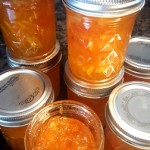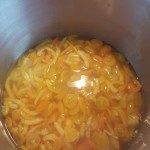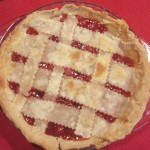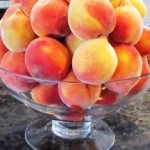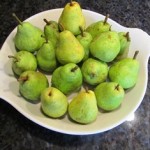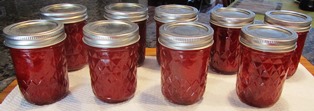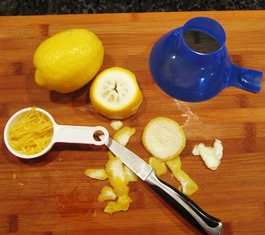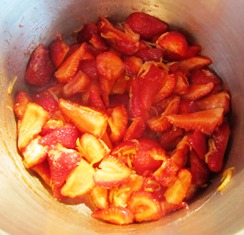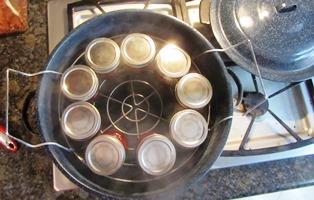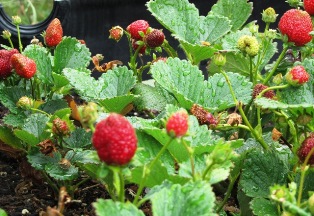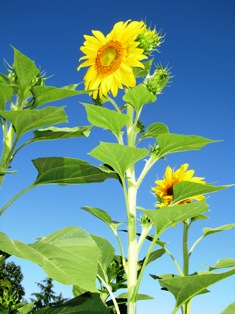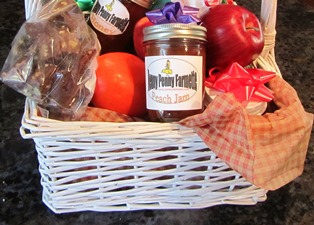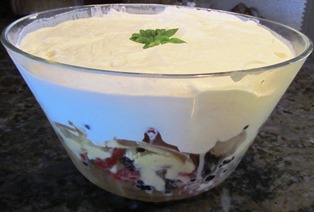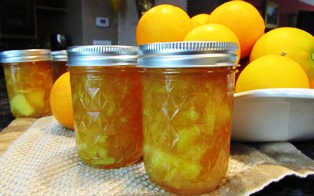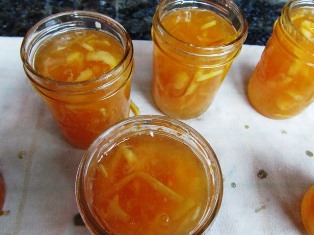Country Fresh Peach Cobbler
Ripe peaches, widely available throughout summer, are delicious in cobblers, pies, and pancakes. They are scrumptious in spreads like jam for toast, on pound cake drizzled in brand or a fruit wine, or over warm bread. Alternatively, pile ripe peaches into a pandowdy, tart, galette, or crostini (the French and Italian versions of a rustic one-crust pie with edges folded over to hold in the fruit).
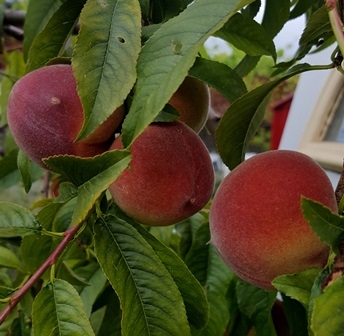
Folks in the Midwest where I grew up enjoy peach cobbler best when served warm with rich vanilla ice cream or piled high with homemade whipped cream. Of course, this cobbler is especially tasty served cold when flavors have time to marinate. To ensure freshness, always refrigerate.

For this peach cobbler recipe, you’ll need about two and one-half pounds of fresh, ripe peaches. Gather your tools, bowls, and ingredients. Preheat the oven to 350 degrees Fahrenheit.
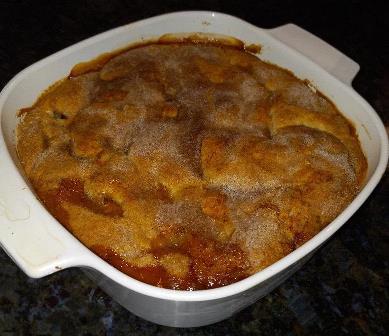
RECIPE: COUNTRY FRESH PEACH COBBLER
Ingredients:
1 cup flour
2 teaspoons baking powder
1/2 cup sugar
6 Tablespoons cold, unsalted butter, cut into cubes
1 large egg, lightly beaten
1/4 cup Half & Half
2 1/2 pounds fresh peaches (peeled, pitted, and sliced)
2 Tablespoons fresh lemon juice
2 Tablespoons apricot preserves
1 teaspoon ground nutmeg or mace and 1/2 teaspoon ground cinnamon for peach filling
1/2 teaspoon ground cinnamon mixed with 2 Tablespoons sugar for topping
Directions to Make Crust
Divide sugar into two equal portions. In a large bowl, pour in the flour, baking powder, and one portion of the sugar. Mix the ingredients until thoroughly combined. Cut four tablespoons of the butter into cubes. Drop pieces of butter into the dry ingredients. Using a pastry cutter or your fingers, integrate the butter into the dry ingredients until the mixture is crumbly. In a separate bowl, beat together egg and Half & Half. Slowly pour this into the dry flour mixture and mix until the dough is moistened, not wet. On a piece of plastic wrap that has been sprinkled with a little sifted flour, shape the dough into a ball, cover with plastic wrap, and refrigerate for 15 minutes.
Directions for Preparing the Peaches
In a medium-size bowl, mix the peeled, pitted, and sliced peaches with lemon juice, nutmeg (or mace), 1/2 teaspoon cinnamon, apricot preserves, and the remaining portion of sugar. In a 1 1/2 quart baking dish, pour in the peach filling. Cut the remaining butter into pieces and add to the peaches.
Directions for Assembling the Cobbler.
Roll out the cobbler dough and place it so that it covers the peaches and stretches to the edge of the baking dish. Seal by crimping the dough around the edges of the dish. Cut vents into the dough. Then sprinkle the cinnamon and sugar mixture over the top of the crust. Bake 30 to 35 minutes. Remove when crust has browned and let cool. Serve with ice cream or whipped cream.
If you enjoy reading about country living, check out the novels based on my farmette life: A Beeline to Murder, The Murder of a Queen Bee, and A Hive of Homicides. All are available from Amazon, Barnes & Noble, and other online retailers as well as bookstores everywhere.

STORAGE PROBLEM? BUILD A SHE-SHED
My biggest issue with our 1,100-square foot house on the Henny Penny Farmette is lack of storage for all our stuff. Okay, so most of it is my stuff.
There’s no good place for the juicer, bread maker, mixer, taco press, deep fryer, sewing machine, dress form, extra dishes and pans, honey buckets, bee keeper suit and gloves, fabric and threads, boxes of jars with rings and lids, books, and art supplies. We keep moving our stuff around to accommodate other stuff.
When I want to put honey into jars, make jam, or do a ceramics project, for example, the process of hunt and find becomes exhaustive. For a ceramics project, I have to track down the tile saw. In my closet, I’ve moved boxes of shoes to accommodate hammers, drills, a box of drill bits, an arm saw, a saws-all, boxes of screws and nails of various sizes, and power tools. Seriously. What woman in her right mind forgoes her collection of high heels for power tools?
My easel, oil paints, brushes, cans of turpentine, and canvases are all stored in different places around the house. Supplies must be found and laid out on the kitchen counter before work on the piece begins. The easel goes up and a time-consuming search begins for the canvases.
The solution to the storage problem might seem obvious. Buy a shed. I did that. But it didn’t turn out so great. I bought a ten-foot square wooden shed to assemble onsite. It was duly delivered. But upon opening the box, we realized how inferior the building materials were. We could see it collapsing under the first hard wind and rainstorm.
- Constructing floor struts
Hubby hurried off to the DIY store in his truck and brought home everything we needed to build a really, strong storage shed. He’s an architect and knows such things. So the piers were set and leveled. The floor struts went in and up went the walls. I’m confident that when it’s finished, it will be a great place to keep all my extra stuff. And my high heels can reclaim their space in my closet.
___________________________________________________________________________________
If you enjoy reading about home renovation, farming topics, gardening, and keeping of chickens and bees, you might be interested in my Henny Penny Farmette series of cozy mysteries: A BEELINE TO MURDER, MURDER OF A QUEEN BEE, and A HIVE OF HOMICIDES. Or, if you like nonfiction, self-help, check out my comprehensive list of books and information about me on Amazon.com, where I maintain an author’s page.
How to Make Kumquat Marmalade
Eating a fresh kumquat–the small relative to the sweet orange–is like getting a dose of Vitamin C in a single bite. Or, if you don’t like the tart fruit (the edible rind is sweet), then make your kumquats into a marmalade.
My neighbor recently brought over several boxes of freshly-picked kumquats. We ate some fresh but I turned the rest into a sweet, spread that tastes quite like orange marmalade.
When fruit is available during the year, you can turn that fruit into a delicious conserve, jelly jam, marmalade, or fruit butter. When citrus is in season, oranges, kumquats, grapefruits, and lemons can be coverted to sweet spreads.
There are distinct differences between conserve, jam, jelly, marmalade, and fruit butter. Conserve is a jam made from fruit with other ingredients added, including raisins, coconut, and nuts. Jelly is made from the juice of the fruit while jam is made from the fruit pulp. Marmalade includes fruit, juice, and rind. A fruit butter utilizes the fruit pulp and sugar to make a thick, smooth spread.
KUMQUAT MARMALADE RECIPE
Ingredients:
2 cups thinly sliced kumquats
1.5 cups chopped orange pulp (2 medium oranges)
1.5 cups sliced orange peel (2 medium oranges)
1/3 cup lemon juice
1.5 quarts water
Sugar (the amount will depend on the amount of fruit/water mixture after 12 hours)
Directions:
Mix together all ingredients, except the sugar, in a deep large pot. Simmer for 5 minutes. Remove from heat and cover. In a cool place, allow the mixture to stand for 12 hours or overnight to soften the rind. Remove any large seeds. Cook rapidly until peel has softened. Measure out fruit and liquid mixture and then add 1 cup of sugar for each cup of the fruit mixture. Stir until the sugar is dissolved.
Rapidly bring the mixture to a boil over high heat. Stir as needed to prevent sticking, especially as the mixture thickens and reaches the gelling point. (Hint: You can check to see if the marmalade is gelling by dropping a spoonful of the hot marmalade onto a chilled or frozen saucer. If the marmalade is sheeting instead of running off the plate, it’s ready to can. Also, you can add Classic Pectin according to directions on container to ensure the marmalade properly thickens). Stir in carefully to avoid splattering on your skin. Remove from heat. If the mixture has foam, skim to remove it. And also remove any large seeds that may have been missed.
Ladle the hot fruit mixture into hot jars (run the jars through a hot rinse cycle as the jam is cooking). Leave 1/4-inch headspace. Tighten the ring around the flat, rubber-seal cap. Place the jars into a boiling-water canner. Bring to a boil and process 10 minutes. Remove jars from canner and let stand until cool. The caps will make a popping sound as they cool and seal.
__________________________________________________________________

- All of Meera Lester’s Henny Penny Farmette mysteries are available online and in bookstores everywhere. Also, check out Meera Lester’s self-help books on health, wellness, and spirituality on Amazon.com See: https://www.amazon.com/Meera-Lester/e/B001JP835E
Swimming in Fruit
Our cherry trees became so heavily laden with fruit this year I couldn’t work fast enough to make the fruit into cookies and pies and jars of jam, conserve, and chutney.
What fruit the birds and squirrels didn’t devour ended up drying on the trees and looking like ornaments. I’m heartened that at least the wildlife will have something to forage on through fall and winter.
The apricot trees did a massive drop of their fruit and seemingly all at once. I made more jam than we’ll probably eat, dried some, and gave away more than a few full buckets of cots to neighbors and friends. I also had to do a messy cleanup of fruit on the ground.
In the cycle now are the summer peaches; so, here I go again . . swimming in fruit.
Next year, I’m going to get my act together early with teams of backyard pickers who can help me remove the fruit, divide it, and distribute it. Right now, however, I’ve got peaches to pick and preserve. The summer pears and figs will be next.
I’m not complaining; I’m enthralled that all this bounty is due to the work of our industrious little honeybees. All this fruit and I haven’t even mentioned finding time to harvest honey. Yet, the bees don’t stop, so neither will I.
________________________________________________________________
If you enjoy reading about farmette topics like keeping bees and chickens, caring for an orchard, or growing heirloom herbs and vegetables, check out my mystery series from Kensington Publishing (due out September 26, 2017).
These novels feature a whodunnit for you to solve and are filled with farming facts, trivia, and delicious recipes. The novels and my other books are available in traditional and online bookstores everywhere. See, http://tinyurl.com/yb42zd2d
What’s Not to Love about Edible Figs?
Many backyard gardeners start checking their fig trees this time of year for ripe fruit. Most figs grown for their fruit bear two crops a year (spring and fall). When figs are ripe, the globular fruit becomes soft and hangs downward from the branch. This fruit will not ripen on the windowsill or in a paper bag, so picking fruit while it is still firm is not advised.
I grow White Genoa, Adriatic, and Brown Turkey figs on my farmette. One of my nearest neighbors grows the Mission fig, which is a very large tree taking up most of his backyard. This time of year, his tree is heavily laden with purple-black fruit. Throughout the fall, that Mission fig tree is frequently visited by the birds, squirrels, and raccoons that eat the fruit.
Cooks appreciate the versatility of figs for cooking. There are many ways to prepare them. Grilled figs are delicious when served on a crostini with a dollop of goat cheese and drizzled with honey. The pulp can be used to make fig bars and other types of cookies. Luscious, juicy figs may be made into chutney or jam, baked in cakes, paired with almonds in a tart, sliced into salads, grilled with lamb, or served simply with port.
Fig trees are easy to grow, too. They need full sun and good drainage; many cultivars are drought tolerant. Lightly prune as necessary in winter. Enjoy.
* * *
If you enjoy reading about farmette topics (including gardening, beekeeping, and delicious recipes), check out my cozy mysteries A BEELINE TO MURDER and also THE MURDER OF A QUEEN BEE in the Henny Penny Farmette series (from Kensington Publishing).
These novels are available through online retailers such as Amazon, Barnes & Noble, Kobo Books, and Walmart as well as from traditional bookstores everywhere.
See, http://tinyurl.com/hxy3s8q
Now available in mass market paperback, this debut novel launched the Henny Penny Farmette series of mysteries and sold out its first press run.
See, http://tinyurl.com/h4kou4g
The second cozy mystery in the Henny Penny Farmette series, available Sept. 27, 2016, is now available on Net Galley (netgalley.com) for professionals and readers who write reviews.
Simple Strawberry Jam
I visited the Clayton Valley Farmer’s Market on Saturday and picked up six baskets of large strawberries trucked up from Watsonville, about a two-hour drive from my farmette.
Of the various cities claiming to be the strawberry capital of the world, Watsonville surely must rank as number one because it produces tons of berries to support its claim–California produces eighty percent of strawberries in America. Many, if not most, come from Watsonville.
Those berries in the green plastic baskets at the farmer’s market were huge and delicious and sweet. Perfect for making into jam. Strawberry jam, seemingly, is everyone’s favorite, and this year I’m making some extra batches.
The recipe is quite simple, with only five ingredients.
STRAWBERRY JAM
Ingredients:
6 1/2 cups of washed, sliced strawberries (about 2 quarts, plus a little more)
1/4 cup thinly sliced lemon peel
7 1/2 tablespoons powdered pectin
1 tablespoon of lemon juice
6 cups granulated sugar
Directions for Preparing Jars:
Place nine jars in the dishwasher.
Simmer the rings and lids in a skillet on low heat.
Fill the hot-water canner with water enough to cover the jars by two inches. Bring the water to a boil.
Directions to Make Jam:
Slice the lemon peel off and remove any remaining white membrane from the peel.
Slice the lemon peel into thin strips.
Place lemon peel in a small pan, cover with water, and boil for five minutes.
Drain the water off the lemon peel.
In a large pot, combine lemon peel, strawberries, pectin, and lemon juice. Bring to a boil.
Stir in the sugar until it is dissolved and then bring the pot to a roiling boil.
Boil hard for 1 minute, stirring constantly to avoid the jam sticking to the bottom of the pan.
Remove the jam pot from heat and skim off any foam as needed.
Remove the jars from dishwasher and turn upside down on a paper towel. Before filling the jars, wipe around the jar mouth to remove wetness and turn upright to fill.
Ladle the hot strawberry jam into each jar, leaving 1/4-inch head space. Wipe any jam spilled on the jar lip that might void a good seal. Then set the two-piece caps in place and screw tight. Process in the hot-water canner for 15 minutes. Makes 9 jars.
Easy Strawberry-Rhubarb Jam

Rhubarb takes up a lot of garden because of its big leaves but the canes pair well with strawberries
Rhubarb and strawberries just seem to go together. Their flavors blend nicely, whether in a compote, trifle, pie, or jam. The following is a simple recipe for strawberry-rhubarb jam and uses the boiling hot water bath to preserve the jars of jam.
Make extra to tuck into holiday gift baskets or for gift-giving throughout the year.
Ingredients:
2 cups strawberries (washed, hulled, and crushed)
2 cups rhubarb (roughly four stalks, chopped)
1/4 cup lemon juice
6 Tablespoons Classic Pectin
5 1/2 cups sugar
Directions:
Combine the first four ingredients (strawberries, rhubarb, lemon juice, pectin) in a large pot.
Bring to a boil.
Add the sugar, stirring to blend completely.
Return the mixture to a roiling boil.
Time for one minute, stirring constantly.
Remove the pot from heat.
Skim away the foam.
Ladle the jam into hot, clean jars, leaving 1/4 inch head space.
Apply and tighten the two-piece ring/lid caps.
Place jars into the boiling water bath canner.
Process for 10 minutes.
Crafts You Can Make from Your Backyard Garden
Invariably, when fall and winter holidays roll around each year, I find myself wishing that I’d planned ahead and utilized more raw materials from the garden for gift-giving. If you have had a similar experience, here are some ideas for turning what you grow into heart-warming gifts.
At summer’s end, harvest the seeds of your favorite flowers like cosmos, sunflowers, nasturtiums, zinnias, and even vegetables. Dry and re-package into paper envelopes that you hand-stamp, emboss, or otherwise embellish for gift-giving. Be sure to include information about how to grow the plant.
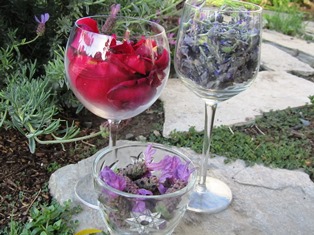
Rose petals, Spanish lavender, and French perfume lavender can be used to make a flower essences or potpourri
Flowers and herbs, picked at their zenith, can be turned into potpourri, fragrant soaps, soothing lotions, and skin moisturizers.
If you keep bees in your backyard garden, consider using the extra wax for dipping candles. Of course, honey is highly prized for its healthful properties, so be sure to jar up plenty of honey for gift-giving occasions.
Vines, berries, and pine cones are easily transformed into wreaths and dry arrangements.
A bottle of vodka, gin, or other spirits can be transformed into a gourmet gift by the addition of sun-ripened berries, herbs, vegetables (such a cucumber), or fruits and then stored in a dark, cool place for at least six weeks.
Gourds make lovely bird feeders and bird houses.
Just imagine the delight a dried-pepper wreath, a garlic braid, or jars of dried beans and seeds might evoke.
Make sheets of homemade paper, incorporating colorful rose petals, lavender, or pansies. Making paper is easy if you have a blender, some scraps of paper (junk mail works), and water.
Seed cakes, created from crunchy peanut butter, seeds, nuts, and dried fruit, make great gifts for bird lovers who can place them near feeders during the cold months when the bird must vigorously forage for food.

Re-potted cuttings of your garden favorites make lovely gifts for other gardeners in your family or circle of friends
Take cuttings in fall or early spring from your roses, dip the cuttings into root hormone, and plant the cuttings into a pot of soil that you keep damp until the roots have formed. Or dig bulbs (bearded irises, for example) and place in a tin for gift-giving.
Preserve jars of pie-filling, do up crocks of pickles, or create mouth-watering chutneys and special relishes. Wrap the jar lids in gingham and ribbon. Use hot-water canning of fruit and citrus into jam, jelly, and marmalade. Place jars of these items into a food basket, made festive with the addition of colorful tea towels or tissue paper and ribbon.
Use clean, dry corn husks for tamale-making, or craft them into corn husk dolls.
With a little forethought and advance planning, you’ll have plenty of backyard bounty to harvest and turn into gifts for almost any holiday or special occasion.
Divine Desserts and Holiday Cheer
We decorated festive holiday baskets for family and friends this year, filling them with tangerines and oranges from our trees, juicy apples, jars of summer fruit jams, and honey. Of course, no holiday basket would be complete without a batch of homemade fudge, some sugar cookies, and bottle of apple cider or a favorite cordial.
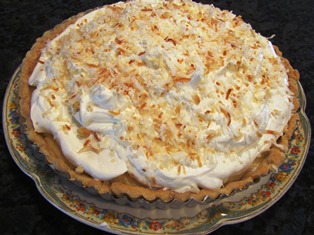
The coconut cream pie piled high with whipped cream and toasted coconut is always a hit for a Christmas dessert
Some of our baskets were delivered on Christmas Eve; others we took with us to a family gathering on Christmas day. I’ve been told that the baskets are much appreciated, more so, since they include homemade treats made with love.
Christmas Eve day my son and I spent most of the day in the kitchen, baking and decorating the cookies, toasting coconut for the pie, and assembling the trifle for our Christmas day dinner.
The trifle bowl went missing this year (we think it was mistakenly taken home by someone after our Thanksgiving feast). But it didn’t really matter since we could make the trifle and put it in any glass bowl that might be deep enough to hold the layers of pound cake and seven cups of various fruits and berries.
We didn’t cook the Christmas dinner this year–my daughter did. But we supplied some a few desserts and a lot of Christmas cheer. Some might say we were blessed with beautiful weather (hovering close to 70 degrees Fahrenheit), but I’d say it’s a mixed blessing–those high, firm peaks of whipped cream in on the trifle and pies will surely soften and sag during transport. But the desserts will still taste divine.
Easy Orange Marmalade
Who can resist the flavors of homemade jams? Whether it embellishes an appetizer of grilled fig and melted goat cheese or is spread upon a fat slice of fresh-baked bread, jam has power to elevate any meal to another level.
Using the seedless oranges growing on our farmette trees, I’m making marmalade. Marmalade made with the oranges ripening this time of year make great additions to holiday gift baskets. I like to add jars of honey, fresh tangerines, nuts, summer jams, and homemade treats.
RECIPE FOR ORANGE MARMALADE
Ingredients:
4 large oranges (preferably a seedless variety)
2 medium lemons
1/2 teaspoon butter (to reduce foaming)
1/8 teaspoon baking soda
6 Tablespoons dry classic pectin
5 1/2 cups sugar
Directions for Preparing the Jars and Canner:
Wash pint jars in the dishwasher or wash the jars and screw rings in hot soapy water, rinse, and drain upside down on paper towels.
Remove the wire rack from the canner and set aside; then, fill the canner half full of water and bring to a simmer.
Directions for Making the Fruit Mixture:
Wash the oranges and lemons.
Peel the fruit, using a vegetable peeler or a sharp paring knife. Discard any seeds and the pithiest parts of the inner peeling as the pith tastes bitter.
Cut the peeled skins into narrow strips.
Pour water into a saucepan.
Add baking soda and strips of peel.
Bring to boil and then reduce the heat, simmering for 20 minutes and stirring as needed.
Cut the fruit into thin quarters.
Add the fruit and juice to the saucepan of simmering peelings, cover, and allow everything to simmer for 10 minutes.
Remove 4 cups of the fruit/peeling/juice mixture and pour into a large saucepan (6 or 8 quart) or stock pot.
Stir in the pectin and add the butter and sugar, mixing well.
Bring to a roiling boil, stirring constantly, for a full minute and then remove from heat, skimming off any foam.
How to Can the Marmalade:
Ladle the fruit mixture into the warm, clean jars, leaving between 1/4 and 1/8 inch space from the top.
Wipe the jar rims before placing the jars on the wire rack of the canner.
Lower the wire rack of jars into the simmering water in the canner.
Make sure the jars are covered by 2 inches of water (add boiling water if necessary).
Cover with lid and boil for 15 to 20 minutes.
Turn off flame, remove the jars of marmalade, and set them onto a towel to cool.
Listen for the popping sound that signals the lids have sealed. Check lids for seal once the jars have cooled by pushing against the center of the lid. If it springs, the jar has not sealed and must be refrigerated. The marmalade will still be good to eat.
 Facebook
Facebook Goodreads
Goodreads LinkedIn
LinkedIn Meera Lester
Meera Lester Twitter
Twitter









